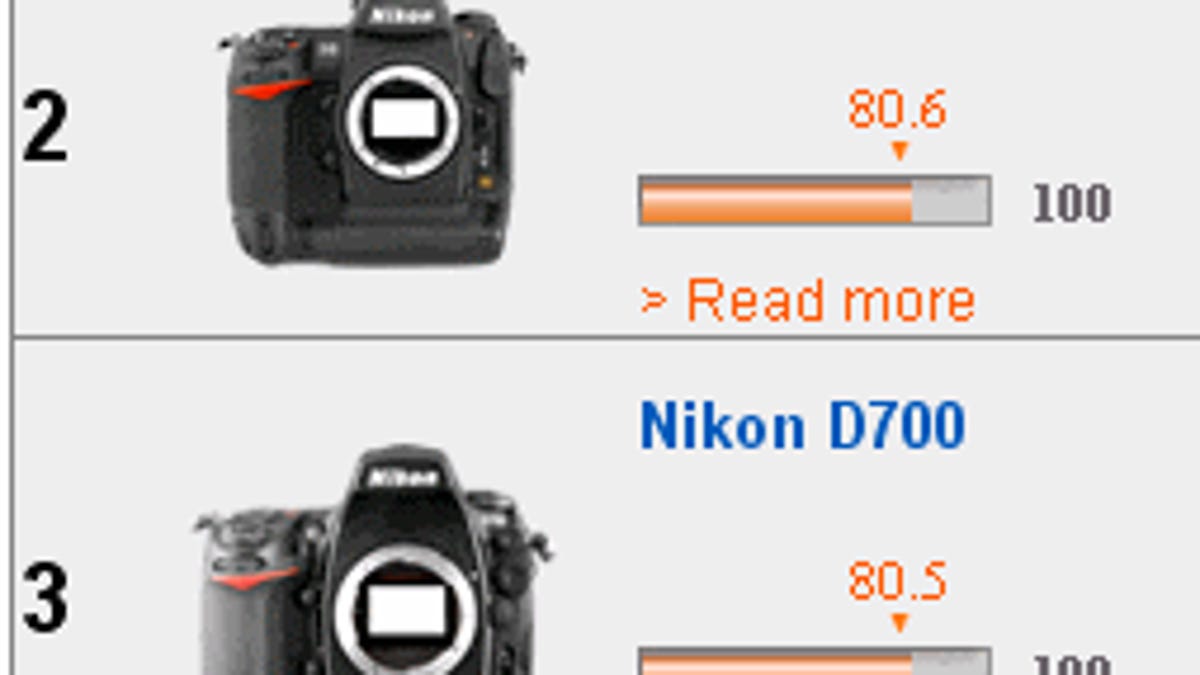Nikon's new SLR leads the pack for sensor quality
Sensor performance of the $8,000 D3X is a big step above Nikon's D3 and Canon's 1Ds Mark III. We're still waiting for medium-format camera tests, though.

It's not a surprise that the Nikon D3X, the company's brand-new $8,000, 24.5-megapixel SLR, tops DxO Labs' sensor performance test. What is a surprise is the margin by which it leads its rivals from Canon and Sony.
When the French firm unveiled its DxOMark Sensor benchmark test last year, Nikon's D3 was the top scorer at 80.6, a composite number that represents various performance features. Very close on its heels were Nikon's D700 at 80.5, Canon's EOS-1Ds Mark III 80.3, and later Canon's 5D Mark II at 79 and Sony's Alpha A900 at 78.9.
All those cameras were close, but the D3X stands apart with a score of 88. The result shows how much ground Nikon has made up on Canon, which has dominated high-end digital SLR technology.
DxO Labs said cameras must be about 5 points apart for people to see a difference; a 15-point difference is equivalent to a full stop of improvement, meaning that a camera would have the same image quality as a rival with half the available light.
The test measures a sensor's color depth, dynamic range, and low-light performance through a variety of detailed tests of the camera. No lens is mounted during the test of the SLRs, so differences from optics are minimized. Unlike other tests, DxOMark Sensor measures performance based on the cameras' raw-format images, which eliminates changes that the camera or software make when converting the raw data into a recognizable photo.
DxO has real chops in the testing business; the company makes a business selling analytical tools and services to camera makers and others. Don't confuse the DxOMark results with a full evaluation of a camera, though; other significant factors include autofocus, in-camera processing, durability, optics, interface, accessories, customer support, and availability of third-party and used lenses.
Sony builds the D3X's sensor with Nikon dictating much of the design.
How exactly did the D3 fare better than its top rival, the 21.1-megapixel 1Ds Mark III, which currently goes for about $6,550? A notch better in color depth, which measures the fineness of gradations between different hues, a big notch better in low-light performance, and a very big notch better in dynamic range, which measures how well the camera can accommodate details in bright and dark areas at the same time.
There's been a lot of teeth-gnashing over the price of the D3X, especially given how much it shares with the $4,100 D3, which still beats out its higher-end sibling on low-light performance and shooting speed. But with most technology, top-end products sell in vastly smaller quantities, and the higher up the ladder you go, the more each step costs.
All the top-scoring cameras employ full-frame sensors, which are the size of a frame of 35mm film from days of yore. The attendant larger pixels and extra light-gathering ability allows much lower noise. Most SLRs sold use smaller, vastly cheaper sensors, of which 200 can be carved from an 8-inch silicon wafer compared to 20 many fewer full-frame chips, according to a Canon white paper on sensors (PDF) from August 2006 that's still relevant. (See update below for a discussion about those numbers.)
Compact cameras use yet-smaller sensors, which shows in part why the performance even of high-end models such as Canon's newer PowerShot G10 significantly trails even elderly, low-end SLRs.
The next big shake-up on the DxOMark list should come in the next few weeks, when DxO Labs adds results from medium-format digital cameras, whose sensors have about twice the area of full-frame SLRs. That will help show just how big a competitive threat these high-end, high-megapixel SLRs are for the studio photographers who are the biggest customers of the super-expensive medium-format models.
DxO Labs also added a new reviews section that describes cameras. So far the D3X is the only camera so featured.
Update 2:06 p.m. PST: Brace yourself for a big tangential digression. Illuminata analyst Gordon Haff, in a chat with me, pointed out that the Canon wafer comparisons from the white paper seem off-base, and I agree.
Here's how the white paper expresses the figures comparing the smaller sensor size, called APS-C, with full-frame: "If the sensors are APS-C size, there are about 200 of them on the wafer, depending on layout and the design of the periphery of each sensor... Full-frame sensors? Just 20." Next to those words is an image of an 8-inch wafer.
The area of an 8-inch wafer, also known as a 200mm wafer, is about 31,416 square millimeters, which isn't enough for even 95 APS-C sensors, much less "about 200." Newer chip manufacturing processes use 300mm wafers with an area of about 70,686 square millimeters, and that would be big enough for 200 APS-C sensors, each of which has an area of about 330 square millimeters.
Indeed, when I asked him about it, Canon Technical Adviser Chuck Westfall told me, "The machine that Canon uses to manufacture its CMOS image sensors for EOS digital SLRs does in fact use a 300mm wafer...Canon has had the capability to use 300mm wafers since at least 2006."
Westfall stood by the figures in the white paper, but in my view the comparison is misleading. It compares how many APS-C wafers fit on a 300mm wafer to how many full-frame sensors fit on a 200mm wafer. But certainly the same overall economics apply: more APS-C chips than full-frame will fit on a given size wafer.

